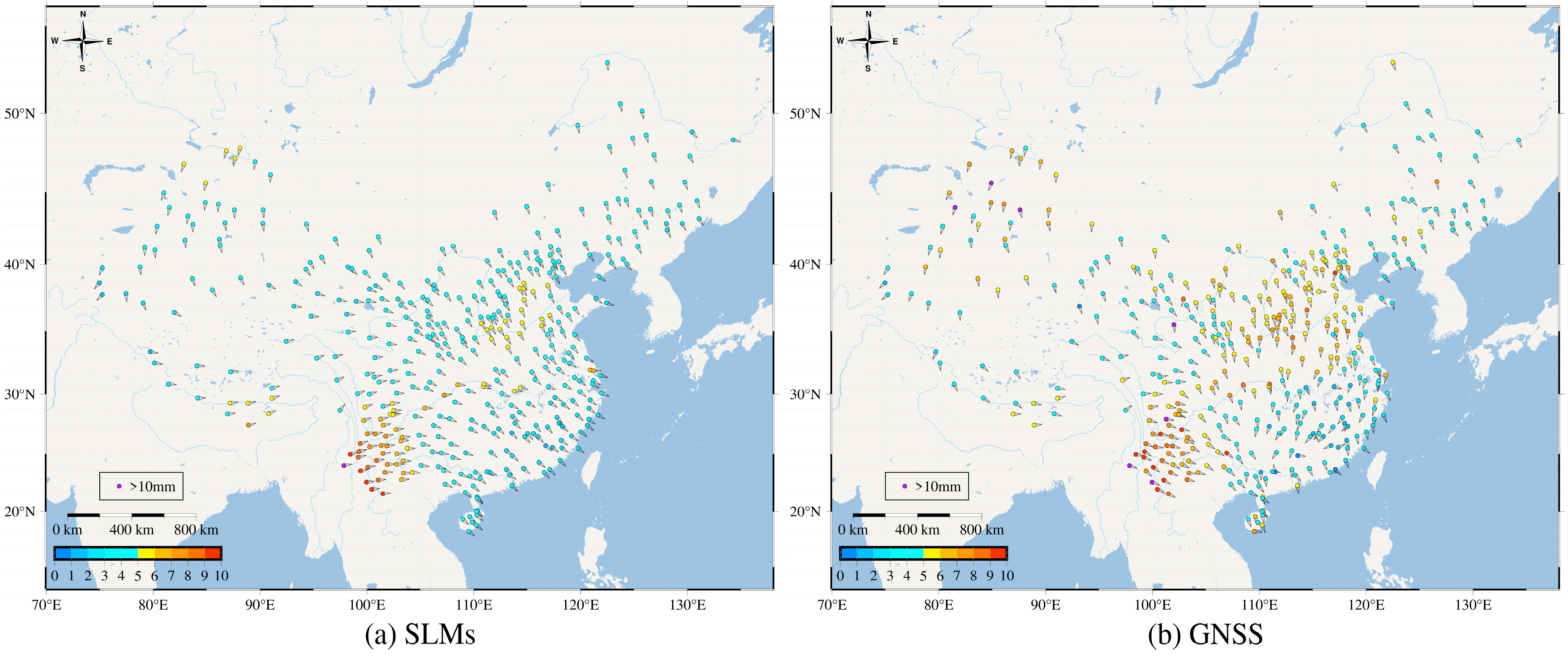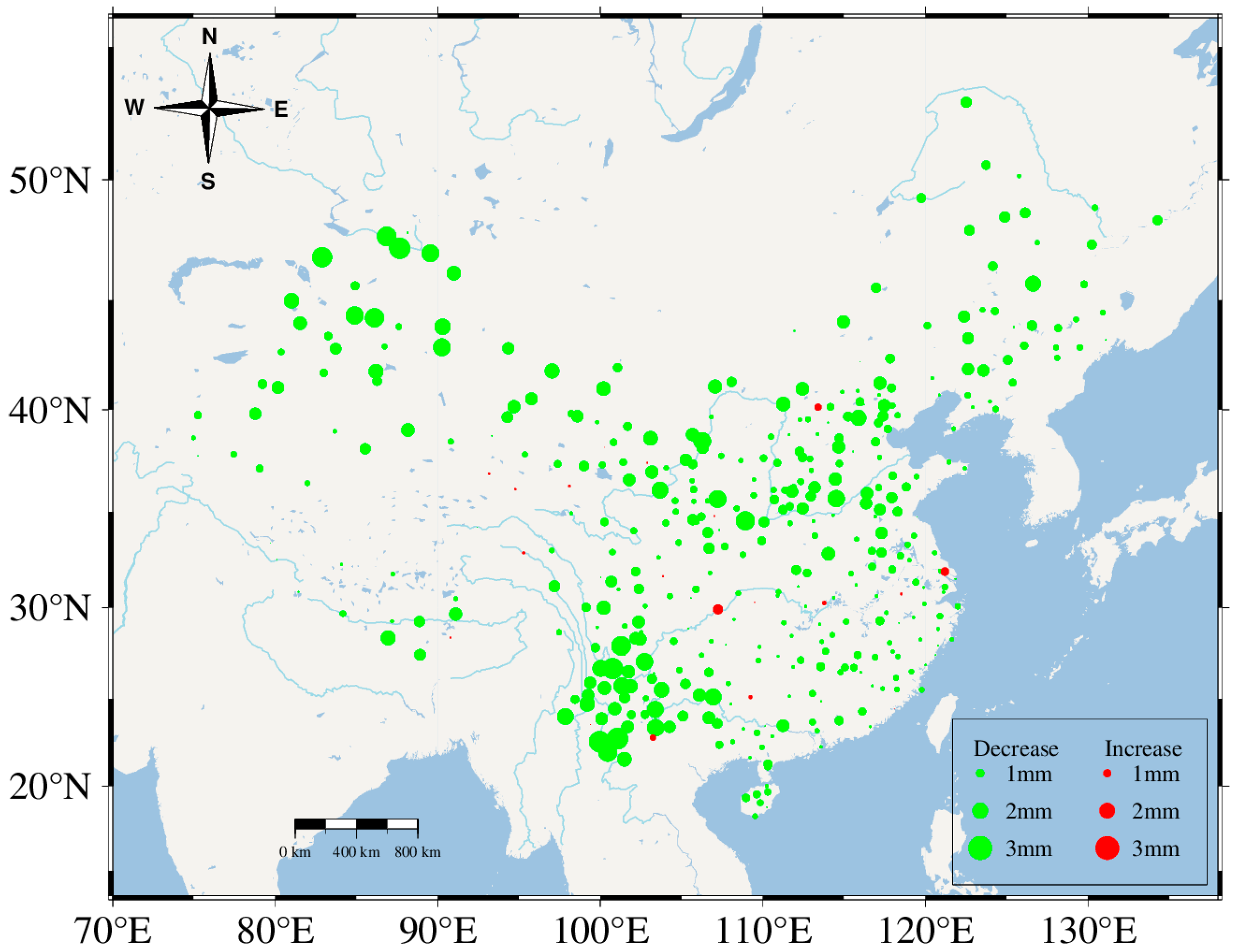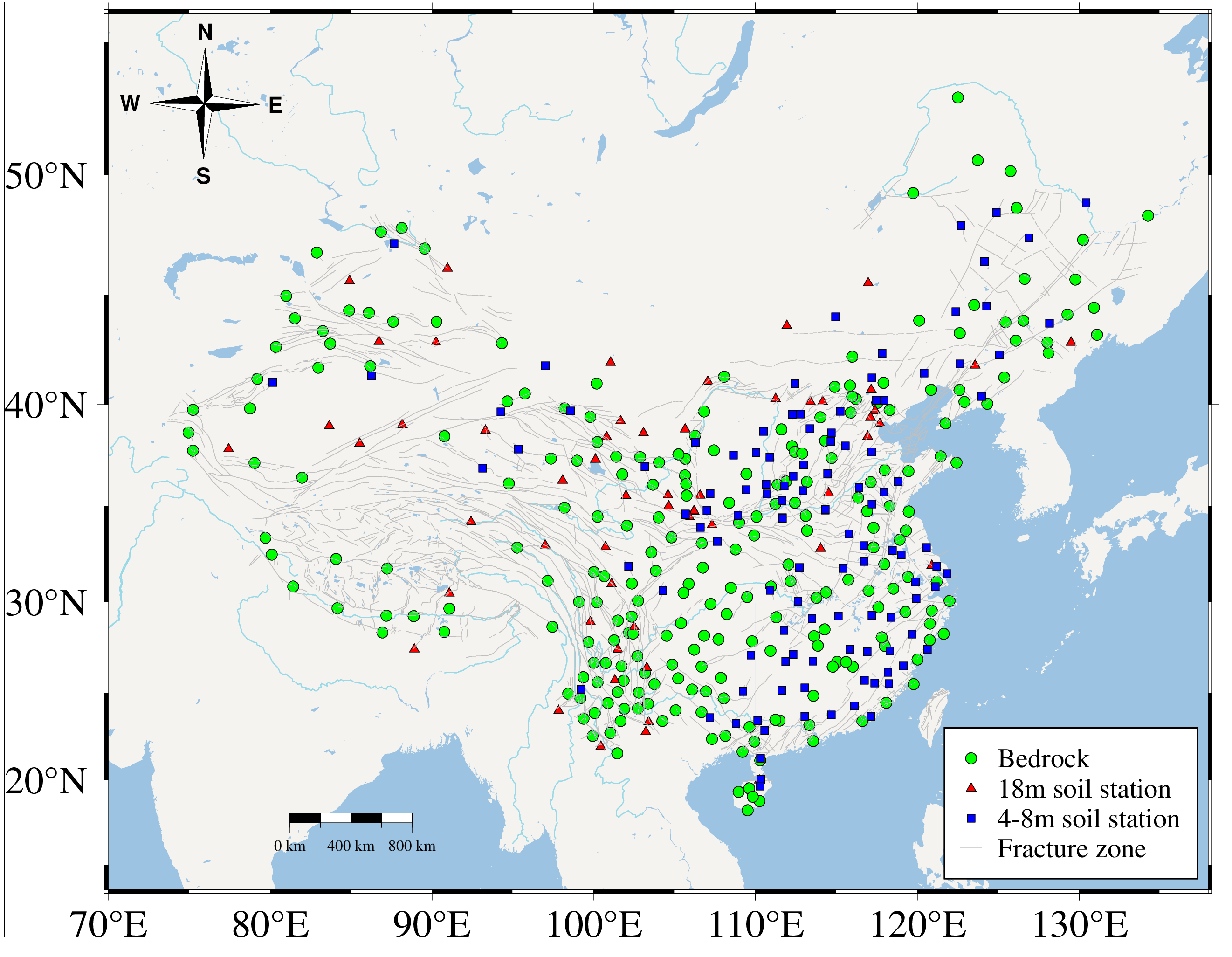Assessing the Nonlinear Changes in Global Navigation Satellite System Vertical Time Series with Environmental Loading in Mainland China
Abstract
:1. Introduction
2. Data
2.1. Environmental Load Data
2.2. GNSS Data
3. Data Processing
4. Data Analysis and Discussion
4.1. Adaptation of the SLMs in Different Areas of Mainland China
4.2. Effect of SLMs on the Vertical Displacement of GNSS in the Mainland of China
4.3. Effect of SLMs on the Vertical Displacement of GNSS Reference Stations with Different Foundation Types
5. Conclusions
Author Contributions
Funding
Data Availability Statement
Conflicts of Interest
References
- Yibin, Y.; Yuanxi, Y.; Heping, S.; Jiancheng, L. Current status and trends of geodesy discipline development. J. Surv. Mapp. 2020, 49, 1243–1251. [Google Scholar]
- Weiping, J.; Chuanyi, X.; Zhao, L.; Guo, Q.; Zahng, S. Analysis of the effect of environmental load on the time series of regional GPS reference stations. J. Surv. Mapp. 2014, 7, 1217–1223. [Google Scholar]
- Hao, M.; Wang, Q.L. Application and research progress of GNSS space geodesy technology in the delineation of active land masses in mainland China. Earthq. Geol. 2020, 42, 283–296. [Google Scholar]
- Jiang, W.; Kaihua, W.; Zhao, L.I.; Xiaohui, Z.; Yifang, M.; Jun, M. GNSS coordinate time series analysis theory and method and prospect. J. Wuhan Univ. Inf. Sci. Ed. 2018, 43, 12. [Google Scholar]
- Wei, N.; Shi, B.; Liu, J.N. Analysis of the influence of surface loading and GPS reference station distribution on reference frame conversion. J. Geophys. 2016, 59, 484–493. [Google Scholar]
- Han, G. Mass loading correction based on geophysical model. In Proceedings of the 2015 Annual Academic Conference of Yunnan Association of Mapping and Geographic Information, Yunnan, China, 22 October 2015; pp. 464–470. [Google Scholar]
- Weijie, T.; Junping, C.; Danan, D.; Weijing, Q.; Xueqing, X. Analysis of the Potential Contributors to Common Mode Error in Chuandian Region of China. Remote Sens. 2020, 12, 751. [Google Scholar] [CrossRef]
- Weijie, T.; Danan, D.; Junping, C. Application of Independent Component Analysis to GPS Position Time Series in Yunnan Province, Southwest of China. Adv. Space Res. 2022, 69, 4111–4122. [Google Scholar]
- van Dam, T.M.; Blewitt, G.; Heflin, M.B. Atmospheric pressure loading effects on Global Positioning System coordinate determinations. J. Geophys. Res. Solid Earth 1994, 99, 23939–23950. [Google Scholar] [CrossRef]
- Van Dam, T.; Wahr, J.; Milly, P.C.D.; Shmakin, A.B.; Blewitt, G.; Lavallée, D.; Larson, K.M. Crustal displacements due to continental water loading. Geophys. Res. Lett. 2001, 28, 651–654. [Google Scholar] [CrossRef]
- Zerbini, S.; Matonti, F.; Raicich, F.; Richter, B.; van Dam, T. Observing and assessing nontidal ocean loading using ocean, continuous GPS and gravity data in the Adriatic area. Geophys. Res. Lett. 2004, 31, L23609. [Google Scholar] [CrossRef]
- Williams, S.D.P.; Penna, N.T. Non-tidal ocean loading effects on geodetic GPS heights. Geophys. Res. Lett. 2011, 38, L09314. [Google Scholar] [CrossRef]
- Dam, T.V.; Collilieux, X.; Wuite, J.; Altamimi, Z.; Ray, J. Nontidal ocean loading: Amplitudes and potential effects in GPS height time series. J. Geod. 2012, 86, 1043–1057. [Google Scholar]
- Bevis, M.; Alsdorf, D.; Kendrick, E.; Fortes, L.P.; Forsberg, B.; Smalley, R., Jr.; Becker, J. Seasonal fluctuations in the mass of the Amazon River system and Earth’s elastic response. Geophys. Res. Lett. 2005, 32, L16308. [Google Scholar] [CrossRef]
- Kusche, J.; Schrama, E. Surface mass redistribution inversion from global GPS deformation and Gravity Recovery and Climate Experiment (GRACE) gravity data. J. Geophys. Res. Atmos. 2005, 110, B09409. [Google Scholar] [CrossRef]
- Lavallée, D.A.; Moore, P.; Clarke, P.J.; Petrie, E.J.; van Dam, T.; King, M.A. J2: An evaluation of new estimates from GPS, GRACE, and load models compared to SLR. Geophys. Res. Lett. 2010, 37, L22403. [Google Scholar] [CrossRef]
- Dong, D. Anatomy of apparent seasonal variations from GPS-derived site position time series. J. Geophys. Res. 2002, 107, 2075. [Google Scholar] [CrossRef]
- Li, Z.; Chen, W.; Van Dam, T.; Rebischung, P.; Altamimi, Z. Comparative analysis of different atmospheric surface pressure models and their impacts on daily ITRF2014 GNSS residual time series. J. Geod. 2020, 94, 42. [Google Scholar] [CrossRef]
- Tregoning, P.; Dam, T.V. Atmospheric pressure loading corrections applied to GPS data at the observation level. Geophys. Res. Lett. 2005, 32, L22310. [Google Scholar] [CrossRef]
- Weichao, S.; Chong, Q. Analysis of optimal correction method for atmospheric mass loading in GPS coordinate time series. Adv. Geophys. 2018, 33, 10. [Google Scholar]
- Nordman, M.; Mäkinen, J.; Virtanen, H.; Johansson, J.M.; Bilker-Koivula, M.; Virtanen, J. Crustal loading in vertical GPS time series in Fennoscandia. J. Geodyn. 2009, 48, 144–150. [Google Scholar] [CrossRef]
- Kathryn, M.; Feng, L.; Lindsey, E.O.; Hill, E.M.; Ahsan, A.; Alam, A.K.M.K.; Oo, K.M.; Than, O.; Aung, T.; Khaing, S.N.; et al. GNSS characterization of hydrological loading in South and Southeast Asia. Geophys. J. Int. 2020, 3, 1742–1752. [Google Scholar]
- Michel, A.; Santamaría-Gómez, A.; Boy, J.P.; Perosanz, F.; Loyer, S. Analysis of GNSS Displacements in Europe and Their Comparison with Hydrological Loading Models. Remote Sens. 2021, 13, 4523. [Google Scholar] [CrossRef]
- Liu, B.; Ma, X.; Xing, X.; Tan, J.; Peng, W.; Zhang, L. Quantitative evaluation of environmental loading products and thermal expansion effect for correcting gnss vertical coordinate time series in taiwan. Remote Sens. 2022, 14, 4480. [Google Scholar] [CrossRef]
- Li, W.; Van Dam, T.; Li, Z.; Shen, Y. Annual variation detected by GPS, GRACE and loading models. Stud. Geophys. Et Geod. 2016, 60, 608–621. [Google Scholar] [CrossRef]
- Fuxun, M.; Liansheng, D.; Boye, Z. GGFC-based environmental load displacement analysis of regional IGS survey stations in China. Surv. Mapp. Geogr. Inf. 2015, 40, 23–25+28. [Google Scholar] [CrossRef]
- Zou, R.; Wang, Q.; Freymueller, J.T.; Poutanen, M.; Cao, X.; Zhang, C.; Yang, S.; He, P. Seasonal hydrological loading in southern Tibet detected by joint analysis of GPS and GRACE. Sensors 2015, 15, 30525–30538. [Google Scholar] [CrossRef] [PubMed]
- Gong, G.; Xianghong, H.; Xiaoxing, H.; Ying, S.; Mengran, M. Regional characterization of surface environmental loading effects in GPS coordinate time series. Geod. Geodyn. 2017, 37, 961–967. [Google Scholar] [CrossRef]
- Wang, M.; Shen, Z.K.; Dong, D.N. Influence of non-tectonic deformation on GPS continuous station position time series and correction. J. Geophys. 2005, 48, 1045–1052. [Google Scholar]
- He, X.; Hua, X.; Yu, K.; Xuan, W.; Lu, T.; Zhang, W.; Chen, X. Accuracy enhancement of GPS time series using principal component analysis and block spatial filtering. Adv. Space Res. 2015, 55, 1316–1327. [Google Scholar] [CrossRef]
- Gu, Y.; Yuan, L.; Fan, D.; You, W.; Su, Y. Seasonal crustal vertical deformation induced by environmental mass loading in mainland China derived from GPS, GRACE and surface loading models. Adv. Space Res. 2017, 59, 88–102. [Google Scholar] [CrossRef]
- Niu, Y.; Wei, N.; Li, M.; Rebischung, P.; Shi, C.; Chen, G. Quantifying discrepancies in the three-dimensional seasonal variations between IGS station positions and load models. J. Geod. 2022, 96, 31. [Google Scholar] [CrossRef]
- Collilieux, X.; Altamimi, Z.; Coulot, D.; van Dam, T.; Ray, J. Impact of loading effects on determination of the International Terrestrial Reference Frame. Adv. Space Res. 2010, 45, 144–154. [Google Scholar] [CrossRef]
- Collilieux, X.; van Dam, T.; Ray, J.; Coulot, D.; Métivier, L.; Altamimi, Z. Strategies to mitigate aliasing of loading signals while estimating GPS frame parameters. J. Geod. 2012, 86, 1–14. [Google Scholar] [CrossRef]
- Jiang, W.; Zhao, L.; Dam, T.V.; Ding, W. Comparative analysis of different environmental loading methods and their impacts on the GPS height time series. J. Geod. 2013, 87, 687–703. [Google Scholar] [CrossRef]
- Dill, R.; Dobslaw, H. Numerical simulations of global-scale high-resolution hydrological crustal deformations. J. Geophys. Res. Solid Earth 2013, 118, 5008–5017. [Google Scholar] [CrossRef]
- Thomas, M.; Dill, R.; Dobslaw, H. ESMGFZ Product Repository, Deutsches GeoForschungsZentrum GFZ. 2016. Available online: http://esmdata.gfz-potsdam.de:8080/repository/entry/show?entryid=e0fff81f-dcae-469e-8e0a-eb10caf2975b (accessed on 1 September 2022).
- Bos, M.S.; Fernandes, R.; Williams, S.; Bastos, L. Fast error analysis of continuous GNSS observations with missing data. J. Geod. 2013, 87, 351–360. [Google Scholar] [CrossRef]
- Yanping, Z.; Peng, Z.; Xianjun, C.; Junli, W.; Donghua, W.; Lei, Z.; Quande, Z.; Zhanyi, S.; Zhihao, J.; Zhicai, L.; et al. Technical Regulation for National Geodetic DatumInfrastructure Modernization; Survey and Mapping Press: Beijing, China, 2012. [Google Scholar]
- Zicai, L.; Peng, Z.; Zhanyi, S.; Fan, W. Research on fast synchronization processing method of large-scale GNSS reference station network. Surv. Mapp. Bull. 2017, 2, 65–69. [Google Scholar]
- Li, Z.; Wen, Y.; Zhang, P.; Liu, Y.; Zhang, Y. Joint Inversion of GPS, Leveling, and InSAR Data for The 2013 Lushan (China) Earthquake and Its Seismic Hazard Implications. Remote Sens. 2020, 12, 715. [Google Scholar] [CrossRef]
- Dach, R.; Lutz, S.; Walser, P.; Fridez, P. (Eds.) Bernese GNSS Software Version 5.2. User manual, Astronomical Institute, University of Bern; Bern Open Publishing: Bern, Switzerland, 2015. [Google Scholar] [CrossRef]
- Kouba, J.; Héroux, P. Precise point positioning using IGS orbit and clock products. GPS Solut. 2001, 5, 12–28. [Google Scholar] [CrossRef]
- Yao, Y.B. Research on the Alorithm and Realization of Post-Processing for GPS Precise Positioning and Orbit Determination; Wuhan University: Wuhan, China, 2004. [Google Scholar]
- Gao, C.; Zhao, Y.; Wan, D. The weight determination of the double difference observation in GPS carrier phase positioning. Sci. Surv. Mapp. 2005, 30, 28–32. [Google Scholar]
- An, C.; Yijiang, W.; Hongdong, L.; Le, W.; Xiaokui, S.; Shunji, H. Non-Linear variation analysis of height time series of north China GNSS reference stations. GNSS World China 2020, 45, 86–91. [Google Scholar] [CrossRef]
- Zhan, W.; Li, F.; Hao, W.; Yan, J. Regional characteristics and influencing factors of seasonal vertical crustal motions in Yunnan, China. Geophys. J. Int. 2017, 210, 1295–1304. [Google Scholar] [CrossRef]
- He, Y.; Nie, G.; Wu, S.; Li, H. Comparative analysis of the correction effect of different environmental loading products on global GNSS coordinate time series. Adv. Space Res. 2022, 70, 3594–3613. [Google Scholar] [CrossRef]
- Hu, S.; Chen, K.; Zhu, H.; Xue, C.; Wang, T.; Yang, Z.; Zhao, Q. A comprehensive analysis of environmental loading effects on vertical GPS time series in yunnan, southwest China. Remote Sens. 2022, 14, 2741. [Google Scholar] [CrossRef]
- He, X.; Montillet, J.P.; Hua, X.; Yu, K. Noise analysis for environmental loading effect on GPS position time series. Acta Geodyn. Et Geomater. 2017, 14, 131–142. [Google Scholar] [CrossRef]









| Weighted Average Amplitude | Maximum Amplitude | Minimum Amplitude | |
|---|---|---|---|
| GNSS | 5.13 | 12.40 | 0.87 |
| GNSS-SLMs | 2.77 | 10.87 | 0.42 |
| Range of Improvement (mm) | −1.25–0 | 0–1 | 1–2 | 2–2.719 |
|---|---|---|---|---|
| Percentage (%) | 4.86 | 54.98 | 34.06 | 6.08 |
| Foundation Type | Number | Number of Reduction | Percentage (%) | GNSS_waa (mm) | G-S_waa (mm) | Waadr (%) |
|---|---|---|---|---|---|---|
| Bedrock | 244 | 221 | 90.57 | 4.95 | 2.51 | 49.37 |
| 18 m soil station | 55 | 54 | 98.18 | 5.44 | 2.19 | 59.61 |
| 4–8 m soil station | 112 | 93 | 83.03 | 4.82 | 2.40 | 46.48 |
| Foundation Type | WRMS (GNSS) | WRMS (GNSS-SLMs) | WRMS (GNSS)-WRMS (GNSS-SLMs) |
|---|---|---|---|
| Bedrock | 7.95 | 6.92 | 1.03 |
| 18 m soil station | 10.18 | 9.09 | 1.09 |
| 4–8 m soil station | 8.45 | 7.47 | 0.98 |
| Foundation Type | Weighted Average Amplitude Decay Rate | Number of Reference Stations | Number of Undecreased Stations |
|---|---|---|---|
| Bedrock | 52.81% | 60 | 1 |
| 18 m soil station | 58.07% | 21 | 0 |
| 4–8 m soil station | 45.29% | 7 | 0 |
Disclaimer/Publisher’s Note: The statements, opinions and data contained in all publications are solely those of the individual author(s) and contributor(s) and not of MDPI and/or the editor(s). MDPI and/or the editor(s) disclaim responsibility for any injury to people or property resulting from any ideas, methods, instructions or products referred to in the content. |
© 2023 by the authors. Licensee MDPI, Basel, Switzerland. This article is an open access article distributed under the terms and conditions of the Creative Commons Attribution (CC BY) license (https://creativecommons.org/licenses/by/4.0/).
Share and Cite
Zhang, J.; Li, Z.; Zhang, P.; Yang, F.; Wu, J.; Liu, X.; Wang, X.; Tan, Q. Assessing the Nonlinear Changes in Global Navigation Satellite System Vertical Time Series with Environmental Loading in Mainland China. Remote Sens. 2023, 15, 4115. https://doi.org/10.3390/rs15164115
Zhang J, Li Z, Zhang P, Yang F, Wu J, Liu X, Wang X, Tan Q. Assessing the Nonlinear Changes in Global Navigation Satellite System Vertical Time Series with Environmental Loading in Mainland China. Remote Sensing. 2023; 15(16):4115. https://doi.org/10.3390/rs15164115
Chicago/Turabian StyleZhang, Jie, Zhicai Li, Peng Zhang, Fei Yang, Junli Wu, Xuchun Liu, Xiaoqing Wang, and Qianchi Tan. 2023. "Assessing the Nonlinear Changes in Global Navigation Satellite System Vertical Time Series with Environmental Loading in Mainland China" Remote Sensing 15, no. 16: 4115. https://doi.org/10.3390/rs15164115
APA StyleZhang, J., Li, Z., Zhang, P., Yang, F., Wu, J., Liu, X., Wang, X., & Tan, Q. (2023). Assessing the Nonlinear Changes in Global Navigation Satellite System Vertical Time Series with Environmental Loading in Mainland China. Remote Sensing, 15(16), 4115. https://doi.org/10.3390/rs15164115











